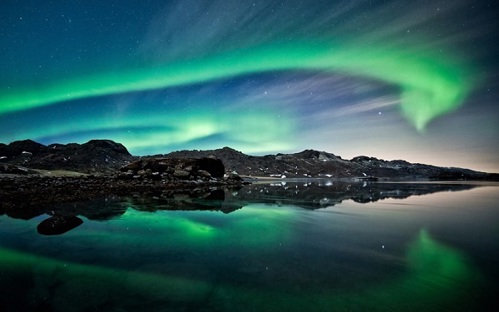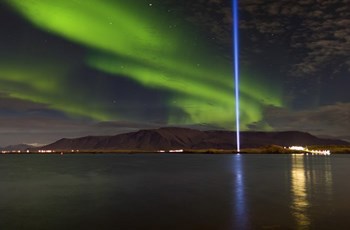The Northern Lights in Iceland

There are few places in the world where the Northern Lights are as visible as Iceland. Because of how far North Iceland is, at a latitude of 65º, you can see the Aurora Borealis a lot of nights during Northern Lights season.
Also, since there are only about 340,000 people living in Iceland scattered across the entire country, it is very easy to find a dark place to view the Northern Lights in all it’s glory.
Viewing the Northern Lights should be on everyone´s bucket list. If you have been thinking about taking a trip to Iceland to see the Northern Lights, we will help you create your dream vacation to Iceland to view the Northern Lights.
See our Northern Lights Tours.
Where and when is the best time to see the Northern Lights in Iceland?
 Areas that are not subject to 'light pollution' are the best places to watch for the lights, although you can see them in the center of Reykjavik (see the photo to the right). Areas in the Icelandic countryside tend to be best. Researchers have also discovered that auroral activity is cyclic, peaking roughly every 11 years. Winter in the north is generally a good season to view the lights. The long periods of darkness and the frequency of clear nights provide many good opportunities to watch the auroral displays. Usually the best time of night (on clear nights) to watch for auroral displays in Iceland is between 9pm to 1am. In order to see Northern Lights we need darkness and clear sky. The best time to see Aurora Borealis in Iceland is from September to Mid April.
Areas that are not subject to 'light pollution' are the best places to watch for the lights, although you can see them in the center of Reykjavik (see the photo to the right). Areas in the Icelandic countryside tend to be best. Researchers have also discovered that auroral activity is cyclic, peaking roughly every 11 years. Winter in the north is generally a good season to view the lights. The long periods of darkness and the frequency of clear nights provide many good opportunities to watch the auroral displays. Usually the best time of night (on clear nights) to watch for auroral displays in Iceland is between 9pm to 1am. In order to see Northern Lights we need darkness and clear sky. The best time to see Aurora Borealis in Iceland is from September to Mid April.
The phases of the moon don't affect aurora activity, but the moonlight can reduce the intensity of the displays. It is often mentioned that full moon should be avoided due to higher light concentration; however it is one of the most magical experiences to see the full moon together with the northern lights dancing across the sky. During a new moon the sky is slightly darker, but it is very much a matter of personal opinion, which of these sightings is the best. The moonlight can add a photographic nuance to the lights.
Myths and Legends related to the Northern Lights:
- In northern latitudes, the effect is known as the aurora borealis (or the northern lights), named after the Roman goddess of dawn, Aurora, and the Greek name for the north wind, Boreas, by Pierre Gassendi in 1621.
- The Cree call this phenomenon the "Dance of the Spirits". "Some elders would say these were loved ones visiting us on this side. Some people weren’t sure if they were loved ones, but they still agreed they were spirits and should be respected." (From the Cree Literacy Network, creeliteracy.org)
- In Europe, in the middle ages, the auroras were commonly believed a sign from God.
- Some Northern American Inuit call the aurora ‘aqsarniit’ (literally ‘football players’) because they believe that the lights are ancestral spirits kicking around the head of a walrus.
- The Old Norse explanation was that the strange, shimmering green lights were old maids dancing in the heavens.
- Vikings believed the glowing lights were reflections from the shields of the Valkyries, maidens who transported fallen warriors to Valhalla.
- Scandinavian fisherman called the sightings Herring Flash as they saw them as a sign of rich catches, believing them to be caused by light reflecting off vast shoals of lively herring.
- Modern day myths exist too - the Japanese believe that babies conceived under the northern lights will become intellectuals.
Our customers love us
John from Texas
...they met every item on our wishlist.
We recently returned from a 10 night Ring Road tour of Iceland and we had a fantastic vacation.
All of the arrangements that Nordika Travel set up for us worked out beautifully. We enjoyed all o






